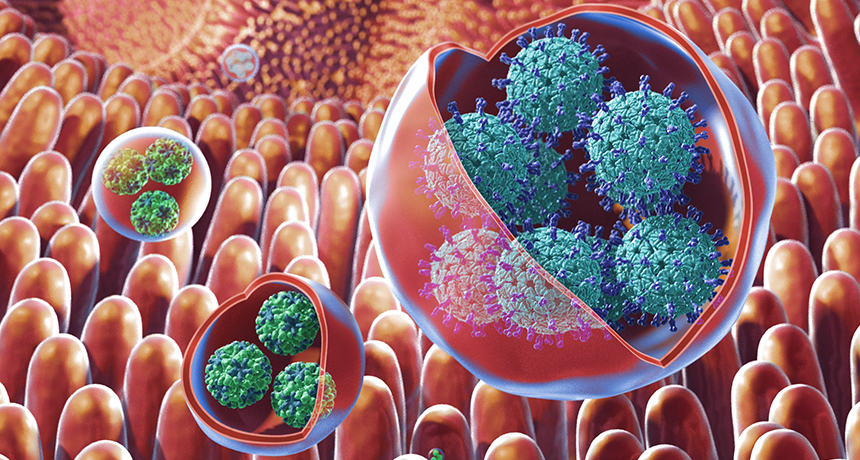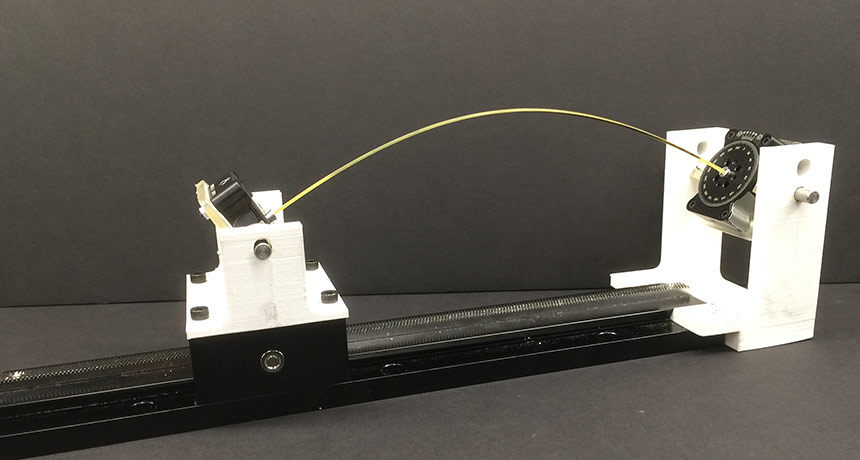How the Parker probe was built to survive close encounters with the sun

NASA has a mantra for preparing spacecraft to launch: “Test as you fly.” The idea is to test the entire spacecraft, fully assembled, in the same environment and configuration that it will see in orbit.
But the Parker Solar Probe, set to launch August 11, is no ordinary spacecraft (SN Online: 7/5/18). And it’s headed to no ordinary environment. Parker will sweep through the sun’s scorching hot atmosphere for humankind’s first close encounter with the star at the center of the solar system.
“Solar Probe is a little bit special,” says space plasma physicist Stuart Bale of the University of California, Berkeley. Getting the whole kit and caboodle into a setting that simulated the sun’s energetic particles, intense light and searing heat “was deemed impossible.” Scientists had to get creative to test the technology that will touch the sun, using everything from huge mirrors to dust tunnels to reams of paper.
Taking the heat
The first order of business was to find materials that can stand the heat. The sun’s outer atmosphere, or corona, sizzles at millions of degrees Celsius — but it is so diffuse that it doesn’t pose much threat to the spacecraft (SN Online: 8/20/17). Direct sunlight, however, can heat exposed components to around 1370° Celsius. Two of the spacecraft’s scientific instruments, plus parts of its solar panels and its revolutionary heat shield, will be exposed to that searing sunlight at all times.
“Normal things … would melt,” says solar physicist Kelly Korreck of the Smithsonian Astrophysical Observatory in Cambridge, Mass.
Korreck works on the Solar Wind Electrons Alphas and Protons instrument, known by its acronym SWEAP, which will catch the charged particles of the solar wind with a sensor called a Faraday cup (SN Online: 8/18/17). “It actually sticks around the heat shield and will be able to touch the sun,” Korreck says. “That cup is special.”
To build the cup and other instruments that will see the sun directly, engineers settled on three main materials — a niobium alloy called C103 that is used in rocket engines, an alloy of titanium, zirconium and molybdenum called TZM, and tungsten. Some cables carrying power to the SWEAP cup are also lined with sapphire, a good insulator at high temperatures. And the probe’s heat shield is made of two kinds of carbon-based materials.
Figuring out how each of these materials would behave in space was tricky. Engineers couldn’t just use an oven to test the metals, which in heat can react with oxygen to rust or corrode. Carbon also can react with oxygen to combust. So the team had to test pieces of the instruments in airless vacuum chambers.
“Getting things hot on Earth is easier than you would think it is,” says Elizabeth Congdon of Johns Hopkins Applied Physics Laboratory in Laurel, Md., the lead engineer for the heat shield. “Getting things hot on Earth in vacuum is difficult.”
One way the Parker team mimicked the sun’s heat was using actual sunlight. Engineers took material samples to the world’s largest solar furnace, the PROMES facility in Odeillo, France. A series of 63 mirrors built on a hillside redirect sunlight onto an enormous concave mirror on the side of an eight-story building. That mirror then focuses the sunlight into a beam no more than 80 centimeters wide that heats materials to 3000° C inside a small vacuum chamber in a laboratory on stilts.
The beam is so hot, “you can take a two-by-four and swing it through the beam, and it burns right off,” Bale says. “Just a flash of smoke and it’s gone.” Bale leads another of the probe’s experiments called FIELDS that also needed heat testing. FIELDS is comprised of five long antennas, four of which will be exposed to the sun, that will measure electric and magnetic fields in the corona.
The SWEAP team needed an even more realistic simulator, one that would deliver intense sunlight at the angles that Parker will experience. They found an unlikely solution in IMAX film projectors, which emit light in a similar range of wavelengths to the sun.
“It took a completely custom test facility to do it,” says astrophysicist Anthony Case of the Smithsonian Astrophysical Observatory, who also works on the SWEAP instrument. He and his colleagues turned four IMAX projectors around so the lamps focused light into a small vacuum chamber, rather than spreading it across a huge screen. That gave the team the right light intensity and angles to test their instrument.
Biting the dust
Solar heat isn’t the only threat to the Parker Solar Probe. The region around the sun is also expected to be full of dust, left over from the formation of the planets. Scientists don’t know exactly how much dust to expect, but it’s likely to be moving almost as fast as the spacecraft, about 170 kilometers per second.
That’s a big worry for Parker’s twin telescopes, together called the Wide-field Imager for Solar Probe, or WISPR. One of the telescopes will be facing the direction that Parker is traveling, so it will be heading directly into the dust storm. “It can’t be protected,” says astrophysicist Russell Howard of the U.S. Naval Research Laboratory in Washington, D.C.
Dust particles hitting the telescope’s lens leave it pocked with little craters. Only 0.6 percent of the lens should be pitted by the end of Parker’s seven-year mission, according to computer models of dust in the inner solar system. But even a few pits can skew the data, so the team wanted to minimize the damage by choosing the right glass.
Howard and colleagues tested three possible materials for the lens in a dust acceleration tunnel at the Max Planck Institute for Nuclear Physics in Heidelberg, Germany. The tunnel accelerated charged iron particles, ranging from half a micrometer to 3 micrometers wide, to speeds between half a kilometer per second to 8 kilometers per second — fast enough for the scientists to extrapolate up to the dust speeds Parker might experience.
Sapphire withstood the barrage best, but it was unclear how it would behave as a lens. The team also rejected diamond-coated BK7 glass, commonly used for space telescopes, after the coating separated from the glass and left an extra ring around the impact spot. Regular, uncoated BK7 was the winner.
What’s what
The Parker Solar Probe will use four sets of scientific instruments plus innovative self-protective measures to explore the environment near the sun. Take a tour of the spacecraft’s tech.
Tap or click to explore the tech.
Swinging the temperatures
Most of the spacecraft won’t have to worry about the dust or the sun’s extreme heat. Aside from SWEAP and FIELDS, almost everything is tucked behind the all-important heat shield.
That 2.5-meter-wide heat shield is made of carbon foam sandwiched between two carbon sheets. The whole thing is just 11.5 centimeters thick, and is coated on the sun-facing side with white ceramic paint to reflect as much sunlight as possible. Even then, that side could get as hot as 1370° C. But behind it, the bulk of the spacecraft will chill at an average of just 30° C (about 85° Fahrenheit).
“We hide in the shadows,” says solar physicist Eric Christian of NASA’s Goddard Space Flight Center in Greenbelt, Md. He’s the deputy principal investigator of the Integrated Science Investigation of the Sun experiment, which will measure solar particles across a wide range of energies. His team was able to build with ordinary materials and skip the rigorous heat testing. “We’re the lucky ones.”
But Parker won’t always be near the sun. The spacecraft’s orbit will bring it as far from the sun as Venus, where temperatures are around –270° C. At that distance, the spacecraft that will touch the sun needs onboard heaters to keep it at 20° C. So Parker needed to be tested for cold and extreme temperature changes, too.
“We’re not just worried about hot cycles, we’re worried about hot then cold then hot then cold,” says Congdon.
In January 2018, the entire spacecraft was lowered into a thermal vacuum chamber at NASA Goddard for two months of testing. The chamber, a cylinder standing 12 meters tall and 8 meters wide, was cooled to –190° C. A radiator glowing at about 315° C represented the heat coming from the back of the heat shield — but most of that heat never reached the scientific instruments since a titanium truss holds the heat shield at a safe distance from the spacecraft’s main body. The team cycled through hot and cold several times to simulate what Parker will experience.
Another challenge was keeping the probe’s solar panels cool. “You think, obviously, you’re going to the sun, solar power makes the most sense,” Congdon says. “But solar panels don’t like to get hot.” So the panels are threaded with veins that carry water to cool them off. The water absorbs heat from the panels and carries it to radiators that release the heat into space.
The solar panels are also on a shoulder joint, so they can tuck behind the heat shield at Parker’s closest approaches to the sun. Only the last row of cells will see the sun then. “That single row of cells can produce the same amount of power as the full wing can when we’re by the Earth,” says solar physicist Nicola Fox of Johns Hopkins Applied Physics Laboratory, the probe’s project scientist.But Parker won’t always be near the sun. The spacecraft’s orbit will bring it as far from the sun as Venus, where temperatures are around –270° C. At that distance, the spacecraft that will touch the sun needs onboard heaters to keep it at 20° C. So Parker needed to be tested for cold and extreme temperature changes, too.
“We’re not just worried about hot cycles, we’re worried about hot then cold then hot then cold,” says Congdon.
In January 2018, the entire spacecraft was lowered into a thermal vacuum chamber at NASA Goddard for two months of testing. The chamber, a cylinder standing 12 meters tall and 8 meters wide, was cooled to –190° C. A radiator glowing at about 315° C represented the heat coming from the back of the heat shield — but most of that heat never reached the scientific instruments since a titanium truss holds the heat shield at a safe distance from the spacecraft’s main body. The team cycled through hot and cold several times to simulate what Parker will experience.
Another challenge was keeping the probe’s solar panels cool. “You think, obviously, you’re going to the sun, solar power makes the most sense,” Congdon says. “But solar panels don’t like to get hot.” So the panels are threaded with veins that carry water to cool them off. The water absorbs heat from the panels and carries it to radiators that release the heat into space.
The solar panels are also on a shoulder joint, so they can tuck behind the heat shield at Parker’s closest approaches to the sun. Only the last row of cells will see the sun then. “That single row of cells can produce the same amount of power as the full wing can when we’re by the Earth,” says solar physicist Nicola Fox of Johns Hopkins Applied Physics Laboratory, the probe’s project scientist.
Up and away
Before Parker can peer into the sun’s secrets, though, it must survive the trip to space.
The violent shaking during a spacecraft’s launch make it a tense time for scientists, even if they’ve tested all of the parts in an acoustic vibration chamber. Watching SWEAP’s vibration test “made me swear,” Korreck says. “It’s very scary to watch this thing you’ve spent 10 years on flop around as it keeps shaking more and more.”
Her team faced an unusual challenge in making Parker ready to rattle. It could not glue screws in place to prevent them from shaking loose, because epoxies would melt in the sunlight. So the SWEAP team twisted thin niobium wire by hand to tie hundreds of screws together in such a way that, if one comes loose, the others hold it in.
Launch can be a high-pressure time for the spacecraft, too — literally. Engineers initially thought Parker’s launch aboard a powerful Delta IV Heavy rocket, would subject the heat shield to a force 20 times that of Earth’s gravity, although later the team realized the launch force wouldn’t be so severe. To make sure the 72.5-kilogram shield wouldn’t bend or break, the team stacked 1,360 kilograms of paper on top of it.
Once it’s passed the final test of launching and deploying, Parker’s first scientific data should start trickling back to Earth in December. These missives will let scientists take the first step to unlocking the secrets of the sun’s superheated atmosphere and its energetic winds.
“It’s like being a proud parent. I worry that something could happen, but I don’t worry that we didn’t prepare or test her well,” Fox says. “I just hope she writes home every day with beautiful data.”
Editor’s note: This story was updated on August 27, 2018 to correct the cooling temperature in the thermal vacuum testing chamber at NASA Goddard.








